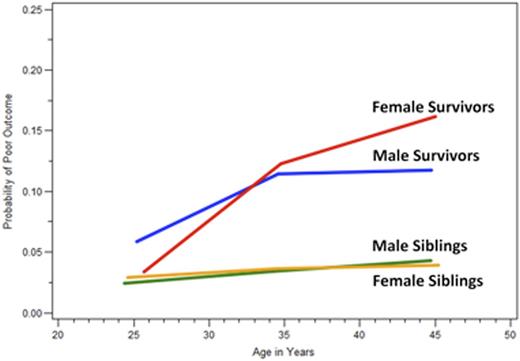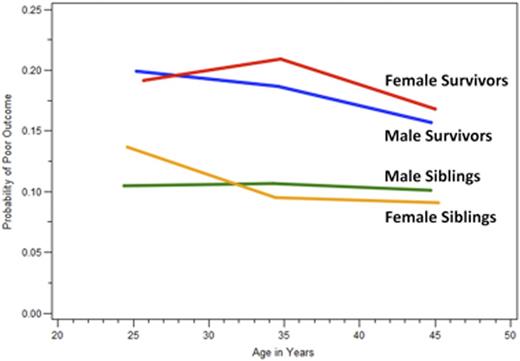Abstract

Hodgkin lymphoma (HL) is one of the most treatable pediatric cancers; however, long-term survivors have many therapy-related late effects. As the number of survivors expands and ages, it is important to determine how aging affects the health status of pediatric HL survivors.
The study included 1,469 5-year HL survivors and 3,206 siblings enrolled in the Childhood Cancer Survivor Study, a multi-center study of childhood cancer survivors and siblings. Six health status domains (general health, functional impairment, activity limitation, mental health, cancer-related pain, and cancer-related anxiety) were analyzed from data longitudinally collected on the baseline and 2 follow-up surveys. Prevalence of poor outcomes (as defined by Hudson et al. JAMA 2003) for survivors and siblings in each domain were compared using multiple logistic regression models and generalized estimating equations. Separate regressions were performed by sex and included survivor/sibling status, age, race, and interaction between age and survivor status. Models were then adjusted for body mass index (BMI) and number of severe, disabling, or life-threatening medical conditions (Common Terminology Criteria for Adverse Events [CTCAE] Grade 3 or 4). Treatment effects were evaluated in survivors in subsequent analyses.
Survivors had higher odds of poor health status outcomes than siblings across all domains, which persisted after adjustment for the number of grade 3 or 4 medical conditions (Table 1). The gap between survivors and siblings increased significantly with age in females in the domains of functional impairment (Figure 1) and mental health (Figure 2), but not in males. The odds ratios (OR) for functional impairment in female survivors versus similarly aged female siblings were 0.8 (95% confidence interval [CI] 0.3-1.9) for 18 - 29 year olds, 2.5 (95% CI 1.6-3.7) for 30 - 39 year olds, and 3.1 (95% CI 2.0-4.8) for 40 year olds and older. Female survivors also reported higher prevalence of grade 3 or 4 conditions than male survivors, with 42% of male and 70% of female survivors 40 years and older reporting 1 or more conditions. These conditions increased the odds of poor health status in both sexes (Table 1). BMI in females and race other than non-Hispanic white in males were also significant predictors of poor health status. No treatment variables were consistently associated with poor health status.
Probability of functional impairment by age. Model adjusted for race, BMI, and number of grade 3 or 4 conditions
Probability of functional impairment by age. Model adjusted for race, BMI, and number of grade 3 or 4 conditions
Probability of poor mental health by age. Model adjusted for race, BMI, and number of grade 3 or 4 conditions
Probability of poor mental health by age. Model adjusted for race, BMI, and number of grade 3 or 4 conditions
Poor health status outcomes in HL survivors versus siblings and the effect of grade 3 or 4 medical conditions*
| . | General Health . | Functional Impairment . | Activity Limitation . | |||
|---|---|---|---|---|---|---|
| . | Males . | Females . | Males . | Females . | Males . | Females . |
| Survivors with Poor Outcome, % Range | 13-17 | 13-18 | 6-23 | 7-30 | 8-15 | 15-27 |
| Overall Survivor vs. Sibling, OR (95% CI) | 2.3 (1.8-3.1) | 1.8 (1.3-2.4) | 2.3 (1.7-3.1) | 2.4 (1.7-3.3) | 1.5 (1.1-2.0) | 1.6 (1.2-2.1) |
| Number of Grade 3/4 Conditions, OR (95% CI) | ||||||
| 1 Condition | 1.9 (1.4-2.6) | 1.7 (1.3-2.3) | 2.6 (1.9-3.7) | 2.0 (1.4-2.8) | 3.3 (2.3-4.8) | 2.3 (1.7-3.0) |
| 2+ Conditions | 3.5 (2.5-5.1) | 4.4 (3.1-6.3) | 6.2 (4.1-9.3) | 4.4 (3.0-6.3) | 8.2 (5.5-12.3) | 5.0 (3.6-6.9) |
| . | General Health . | Functional Impairment . | Activity Limitation . | |||
|---|---|---|---|---|---|---|
| . | Males . | Females . | Males . | Females . | Males . | Females . |
| Survivors with Poor Outcome, % Range | 13-17 | 13-18 | 6-23 | 7-30 | 8-15 | 15-27 |
| Overall Survivor vs. Sibling, OR (95% CI) | 2.3 (1.8-3.1) | 1.8 (1.3-2.4) | 2.3 (1.7-3.1) | 2.4 (1.7-3.3) | 1.5 (1.1-2.0) | 1.6 (1.2-2.1) |
| Number of Grade 3/4 Conditions, OR (95% CI) | ||||||
| 1 Condition | 1.9 (1.4-2.6) | 1.7 (1.3-2.3) | 2.6 (1.9-3.7) | 2.0 (1.4-2.8) | 3.3 (2.3-4.8) | 2.3 (1.7-3.0) |
| 2+ Conditions | 3.5 (2.5-5.1) | 4.4 (3.1-6.3) | 6.2 (4.1-9.3) | 4.4 (3.0-6.3) | 8.2 (5.5-12.3) | 5.0 (3.6-6.9) |
| . | Mental Health . | Cancer-related Pain . | Cancer-related Anxiety . | |||
|---|---|---|---|---|---|---|
| . | Males . | Females . | Males . | Females . | Males . | Females . |
| Survivors with Poor Outcome, % Range | 13-21 | 15-25 | 6-15 | 6-23 | 12-14 | 17-20 |
| Overall Survivor vs. Sibling, OR (95% CI) | 1.7 (1.3-2.0) | 1.6 (1.3-2.0) | N/A | N/A | N/A | N/A |
| Number of Grade 3/4 Conditions, OR (95% CI) | ||||||
| 1 Condition | 1.5 (1.1-2.0) | 1.5 (1.2-1.9) | 1.9 (1.2-3.1) | 1.7 (1.1-2.7) | 1.2 (0.8-1.9) | 1.1 (0.8-1.5) |
| 2+ Conditions | 2.4 (1.7-3.5) | 2.5 (1.9-3.4) | 4.3 (2.6-7.2) | 3.8 (2.4-5.9) | 1.6 (1.0-2.6) | 1.9 (1.3-2.7) |
| . | Mental Health . | Cancer-related Pain . | Cancer-related Anxiety . | |||
|---|---|---|---|---|---|---|
| . | Males . | Females . | Males . | Females . | Males . | Females . |
| Survivors with Poor Outcome, % Range | 13-21 | 15-25 | 6-15 | 6-23 | 12-14 | 17-20 |
| Overall Survivor vs. Sibling, OR (95% CI) | 1.7 (1.3-2.0) | 1.6 (1.3-2.0) | N/A | N/A | N/A | N/A |
| Number of Grade 3/4 Conditions, OR (95% CI) | ||||||
| 1 Condition | 1.5 (1.1-2.0) | 1.5 (1.2-1.9) | 1.9 (1.2-3.1) | 1.7 (1.1-2.7) | 1.2 (0.8-1.9) | 1.1 (0.8-1.5) |
| 2+ Conditions | 2.4 (1.7-3.5) | 2.5 (1.9-3.4) | 4.3 (2.6-7.2) | 3.8 (2.4-5.9) | 1.6 (1.0-2.6) | 1.9 (1.3-2.7) |
OR: odds ratio, CI: confidence interval, N/A: non-applicable
Models adjusted for age, age*survivor status, race, and BMI
Pediatric HL survivors have increased odds of poor health status compared to siblings. Aging further increases this burden for female survivors in the domains of functional impairment and mental health. Survivors of both sexes continue to develop serious medical conditions with aging, which increase the odds of poor health status. Pediatric HL survivors require early interventions to improve health status and close screening to diagnose medical conditions before they negatively impact quality of life.
No relevant conflicts of interest to declare.
Author notes
Asterisk with author names denotes non-ASH members.

This icon denotes a clinically relevant abstract



This feature is available to Subscribers Only
Sign In or Create an Account Close Modal